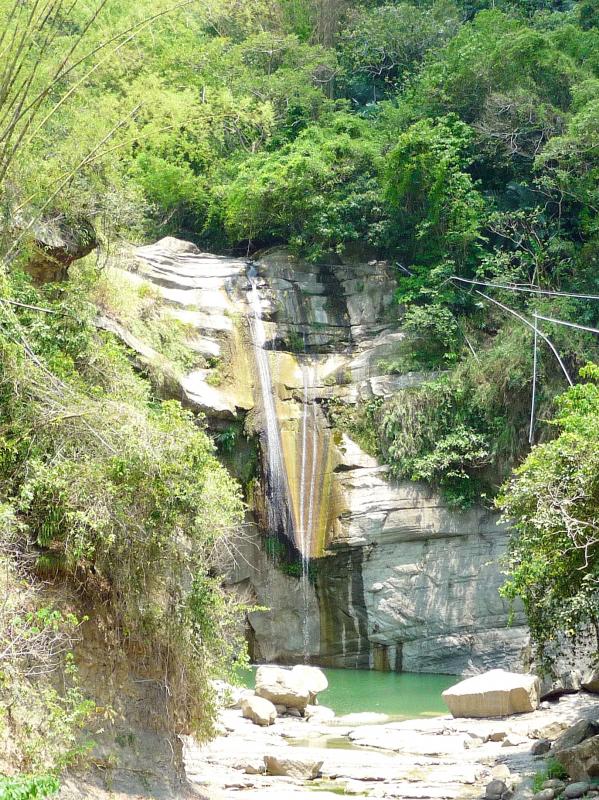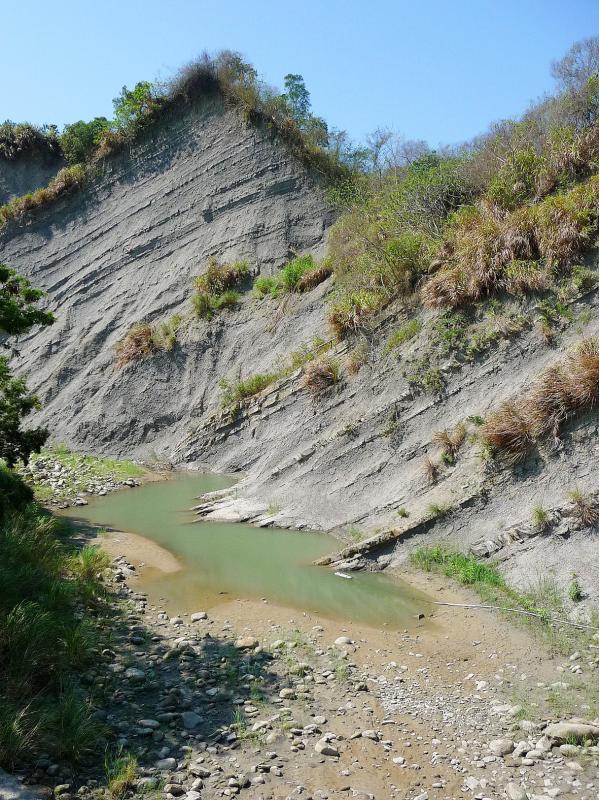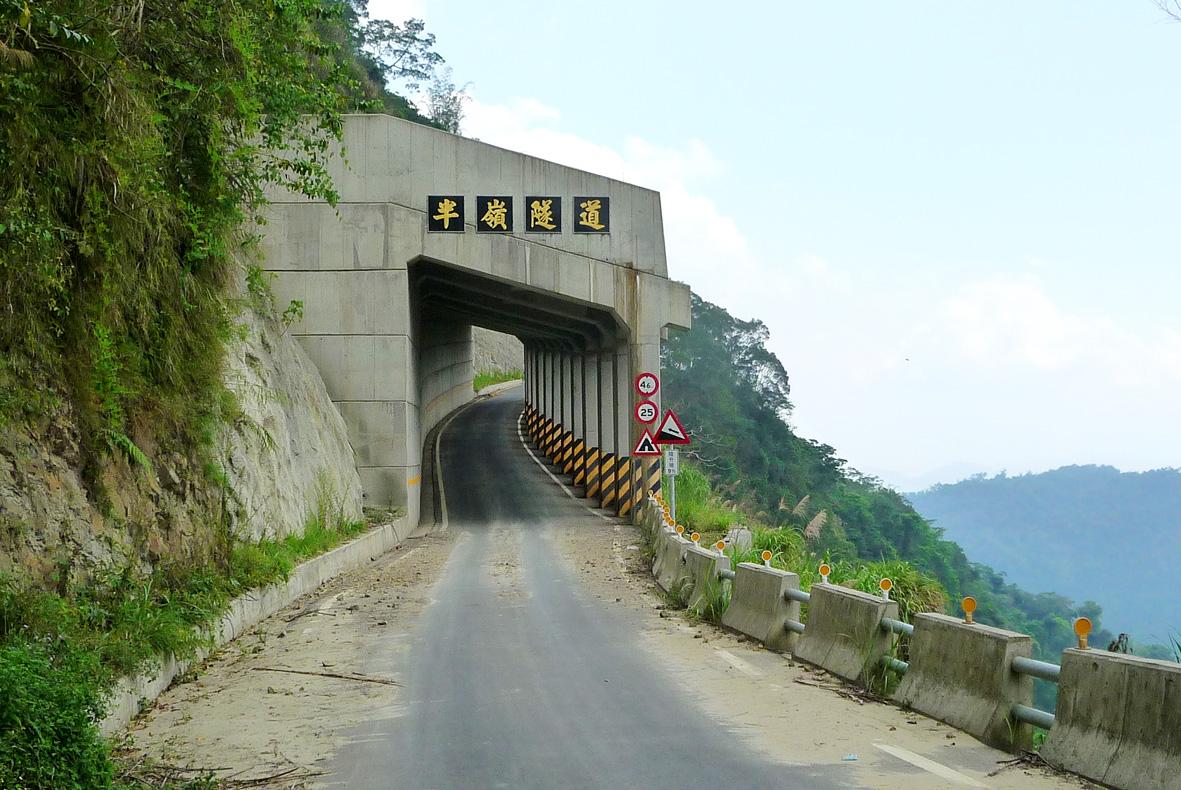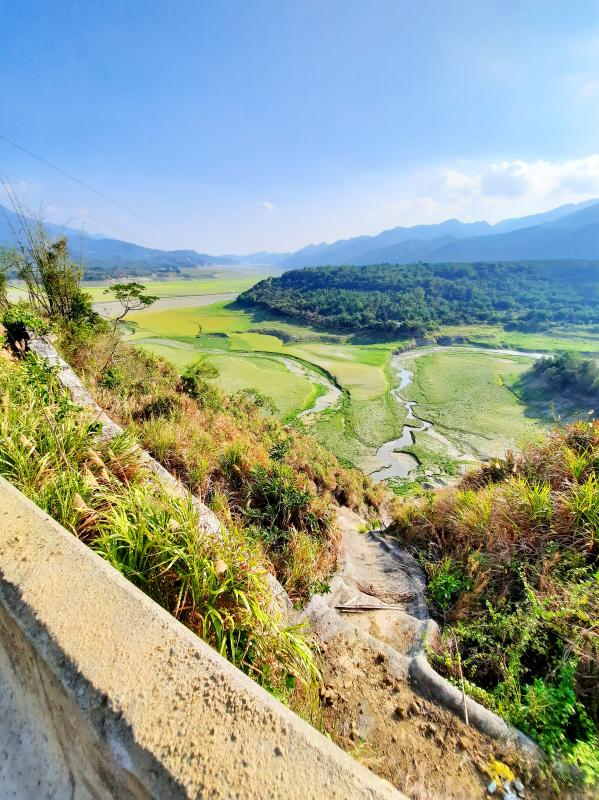The morning after the ride, my hands ached in a way I’d never before experienced, and my palms looked slightly bruised. Flexing my fingers as I waited for my coffee to cool down, I knew exactly which part of the previous day’s excursion had done this to me.
As the go-to-work rush hour ebbed, I’d set off inland on my 125cc scooter. I took Provincial Highway 20 as far as Tainan City’s Yujing District (玉井). From there, I took Provincial Highway 3 into Nansi District (楠西).
The route I’d planned would take me past the eastern side of Zengwen Reservoir (曾文水庫) and into Fanlu Township (番路) in Chiayi County. North of the reservoir, I hoped to ride up to an altitude of about 1,000m via a minor road I hiked on in the distant past. I’d then return to approximately 330m above sea level by a road that would be completely new to me.

Photo: Steven Crook
The section of Highway 3 that runs through Nansi, Dapu Township (大埔) and Fanlu is ideal for two-wheelers. It’s well maintained and intensely scenic. Beyond the built-up part of Nansi, it climbs over hills and through fruit-growing territory. At the tiny village of Shuangsi (雙溪), the highway crosses a tributary of the Zengwen River (曾文溪).
About 4km further along, Highway 3 leaves Tainan City and enters Chiayi County’s Dapu Township. Almost immediately (by the 349.5km-marker on Highway 3), I turned left down Chiayi Local Road 145-1 to get some photos of the “wet” side of the dam that holds back what is, in terms of design capacity, the largest reservoir in Taiwan.
Returning to Highway 3, I paused near the 341km-marker, where Chiayi Local Road 147 emerges from the unpopulated interior. This is another lovely backcountry route.

Photo: Steven Crook
The little lakeside town of Dapu has a gas station where I filled my tank. Continuing north on Highway 3, I crossed the Zengwen River and made a short detour to Cingyun Falls (青雲瀑布). I didn’t expect an impressive torrent — this was a week before the “plum rains” began — and so wasn’t disappointed to see just a few braids of water.
The quantity of traffic dwindled to almost nothing. Many of the few buildings I saw seemed to be no longer occupied. In the distance, there were cliffs of the kind I associate with Greater Alishan.
About 14km beyond the bridge over the Zengwen River, I stopped and double-checked my location. I was where I wanted to be: a spot called Zongsing (總興), right by the intersection of Chiayi Local Road 131-1 and Highway 3.

Photo: Steven Crook
Many years ago, on three or four occasions, with various friends or alone, I’d taken a bus from Chiayi City to Longmei (龍美) on Provincial Highway 18, walked from there to Zongsing, then hitched a lift to the lowlands.
Zongsing has a bus stop (the twice daily #7301 linking Chiayi City with Dapu is the only service), a solitary traditional house and Chinese-only signs to Banling (半嶺). Formosan macaques hopped from tree to tree; I didn’t see any humans.
Local Road 131-1 is steep but the gradient isn’t excessive. Much of it is so narrow that cars and motorcycles can only pass with the greatest of care. Luckily, I encountered no more than five cars during the 25 minutes it took me to cover the 9.45km from Zongsing to where Road 131-1 merges with Chiayi Local Road 131.

Photo: Steven Crook
If I’d turned right and ridden 2.4km, I’d have arrived at Highway 18. Instead, I turned left and followed the mostly level and reasonably wide road to Caoshan village(草山, elevation about 950m). This was exactly what I’d expected: Road 131-1 is a branch of Road 131. If one is more driver-friendly than the other, it would surely be the principal, not the subsidiary, route.
As far as Caoshan — where I saw the greatest amount of human activity since the gas station at Dapu — it’s a lovely road. By the way, Caoshan’s claim to fame is its population of Formosan giant cicadas. These insects are not only rare but also the largest cicadas found in Taiwan.
Beyond Caoshan, the road deteriorates, probably because hardly anyone uses it. Tarmac gave way to concrete. I had to weave between wide cracks and deep splits.
At first, the gradient wasn’t too bad. I switched off the engine and tried to coast downhill without losing control. If the surface had been kinder, the road wider or straighter, I’d have felt more confident. In most places, skidding off the side would have put me into a ravine.
ACHING HANDS
And this is where the bruises and aches come in. Gripping the brakes hard, then releasing them a fraction to move forward a meter or two at a time, I sweated with nervousness as I made my way down into the valley. I was getting closer to the river that separated me from Highway 3.
And then I got lost. At a fork in the road, I assumed the wider, more rideable option was the one I should take. I eventually reached Highway 3 after a frustrating 45 minutes on rough farmers’ tracks.
The struggle had been worth it in at least two senses. For some reason, the valley’s eagles like to fly exceptionally low, so I got a good look at a number of raptors. And while creeping down Road 131, it had occurred to me: Nowhere in Taiwan have I seen a place more suitable for large-scale rewilding than this corner of Chiayi County.
True Nature Foundation defines rewilding as “a form of environmental conservation and ecological restoration that has significant potential to increase biodiversity, create self-sustainable environments and mitigate climate change. Rewilding aims to do this by reintroducing lost animal species to natural environments.”
In 21st-century Taiwan, telling indigenous people how they can or cannot use their ancestral lands is politically difficult. But this part of Chiayi is dominated by Han people — and they’re disappearing, hence the abandoned homesteads I saw.
The Society of Wilderness, an environmental NGO headquartered in Taipei, manages some small rewilding projects in Taiwan. But restoring thousands of hectares to a truly natural state would take decisive government action, or the support of a billionaire willing to not only buy the land, but also to fund the necessary research and planting.
Anders and Anne Holch Povlsen, Scotland’s largest private landowners, are combining their adjoining estates and reversing generations of mismanagement to restore natural habitats. Do any Taiwanese tycoons have this kind of vision?
Steven Crook has been writing about travel, culture and business in Taiwan since 1996. He is the author of Taiwan: The Bradt Travel Guide and co-author of A Culinary History of Taipei: Beyond Pork and Ponlai.

This month the government ordered a one-year block of Xiaohongshu (小紅書) or Rednote, a Chinese social media platform with more than 3 million users in Taiwan. The government pointed to widespread fraud activity on the platform, along with cybersecurity failures. Officials said that they had reached out to the company and asked it to change. However, they received no response. The pro-China parties, the Chinese Nationalist Party (KMT) and Taiwan People’s Party (TPP), immediately swung into action, denouncing the ban as an attack on free speech. This “free speech” claim was then echoed by the People’s Republic of China (PRC),

Exceptions to the rule are sometimes revealing. For a brief few years, there was an emerging ideological split between the Democratic Progressive Party (DPP) and Chinese Nationalist Party (KMT) that appeared to be pushing the DPP in a direction that would be considered more liberal, and the KMT more conservative. In the previous column, “The KMT-DPP’s bureaucrat-led developmental state” (Dec. 11, page 12), we examined how Taiwan’s democratic system developed, and how both the two main parties largely accepted a similar consensus on how Taiwan should be run domestically and did not split along the left-right lines more familiar in

Specialty sandwiches loaded with the contents of an entire charcuterie board, overflowing with sauces, creams and all manner of creative add-ons, is perhaps one of the biggest global food trends of this year. From London to New York, lines form down the block for mortadella, burrata, pistachio and more stuffed between slices of fresh sourdough, rye or focaccia. To try the trend in Taipei, Munchies Mafia is for sure the spot — could this be the best sandwich in town? Carlos from Spain and Sergio from Mexico opened this spot just seven months ago. The two met working in the

Many people in Taiwan first learned about universal basic income (UBI) — the idea that the government should provide regular, no-strings-attached payments to each citizen — in 2019. While seeking the Democratic nomination for the 2020 US presidential election, Andrew Yang, a politician of Taiwanese descent, said that, if elected, he’d institute a UBI of US$1,000 per month to “get the economic boot off of people’s throats, allowing them to lift their heads up, breathe, and get excited for the future.” His campaign petered out, but the concept of UBI hasn’t gone away. Throughout the industrialized world, there are fears that